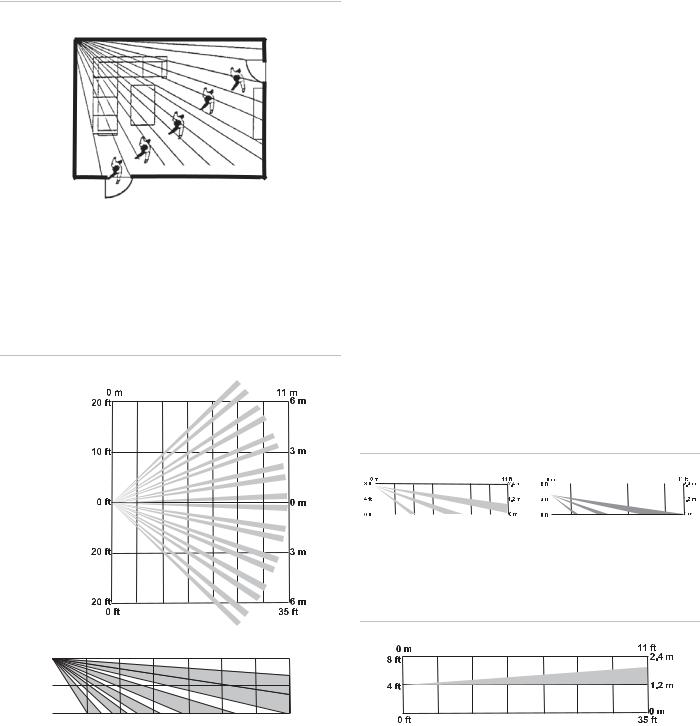Interlogix NX-481 User Manual

SAW PIR and Pet Immune Motions Sensors with 1.5 V Lithium Batteries Installation Instructions
Product summary
A motion sensor (passive-infrared or PIR) detects movement within a specific area by sensing the infrared energy emitted from a body as it moves across the sensor’s field of view.
When this motion is detected, the sensor transmits an alarm signal to the control panel.
Figure 1: SAW PIR and Pet Immune Motion Sensors
Use these motion sensors to protect locations where door/window sensors are impractical or not needed. For example, use a motion sensor to protect large areas or open floor plans. Motion sensors also provide backup protection for door/window sensors.
The Pet Immune SAW PIR (60-807-02-95R) utilizes advanced signal processing, a new custom designed lens, and a new custom designed sensing element. The combination of these improvements provides false alarm immunity for pets with a combined weight of up to 40 pounds while still providing superior human catch performance.
Note: Use only AA 1.5 Volt Lithium Iron Disulfide batteries (part # 60-931) with this product. Do not substitute any other brand/type of batteries.
These wireless motion sensors include the following features:
•35 by 40 ft. coverage area.
•Masking kit provided to block portions of the coverage area (60-639-02-95R).
•Three minute transmitter lockout time after an alarm that helps extend battery life.
•Cover-activated tamper (optional wall-activated tamper is included).
•Supervisory signals transmitted every 64 minutes to the control panel.
•Sensor low battery reports (trouble) to the control panel.
•Field-selectable sensitivity options (60-639-02-95R).
Installation guidelines
Use the following guidelines for installing motion sensors.
•If possible, locate sensors within 100 ft. of the panel. While a transmitter may have a range of 500 ft. or more out in the open, the environment at the installation site can have a significant effect on transmitter range. Sometimes a change in sensor location can help overcome adverse wireless conditions.
•The recommended mounting height is 7 1/2 ft., but the sensor can be mounted from 5 to 8 ft. high in the corner of the area you want to protect. See the animal alley lens guidelines for mounting the optional animal alley lens (60- 639-02-95R only). Higher mounting provides better range (up to 35 ft.), and lower mounting provides better protection close to the motion sensor (see Figure 3 on page 2 and Figure 4 on page 2). The optional swivel mount (part #60-737) can be used for difficult mounting locations with the SAW PIR (60-639-02-95R) only.
•Position the sensor to protect an area where an intruder would be most likely to walk across the detection pattern (see Figure 2 on page 2).
P/N 466-1982 • REV B • January 2011 |
1 |

Figure 2: Overhead detection path
Person walking across detection path
•Mount the motion sensor on a rigid surface which is free from vibrations.
•The pet must not be allowed to climb on objects such as furniture, boxes, etc. within the field of coverage. See Figure 3 below to determine the sensor’s field of coverage.
Figure 3: Standard and animal alley lens coverage area
Top View
Side View (Pet Immune 60-807-02-95R) |
11 ft |
|
7½ Foot Mounting Height |
||
2.4 m |
1.2 m
0 m
35 ft
• Mount the sensor permanently on a flat wall or in a corner. Do not set it on a shelf.
•Windows should be closed in any area which has an armed motion sensor.
•A pet will trigger a (60-639-02-95R) motion sensor. See animal alley lens guidelines to use a motion sensor when pets are present, or use the Pet Immune PIR (60-807-02- 95R).
•Mount the motion sensor on an insulated, outside wall facing in.
•The sensor (60-807-01-95R) must be incline-mounted on a wall surface or incline mounted in a corner at a mounting height of 7.5 ft. (see Figure 4 below).
•The sensitivity switch must be set to Standard (60-807-01- 95R).
•Room temperature must be kept between 60 and 120°F.
•Position the sensor so it faces a solid reference point, like a wall.
Figure 4 below shows the differences in the coverage area when using the motion sensor’s standard lens mounted at different heights.
Figure 4: Standard lens mounted at different heights
Side Views (60-639-02-95R Motion Sensor Standard Lens)
7 ½ Foot Mounting Height |
|
|
5 Foot Mounting Height |
|||
|
|
|
|
|
|
|
|
|
|
|
|
|
|
Figure 5 below shows the side view of the sensor’s animal alley lens when the flush-mount position is used.
Figure 5: Animal alley lens when flush-mounted
Side View Motion Sensor Animal Alley Lens
Flush Mount
•Do not aim the sensor at windows, fireplaces, air conditioners, area heaters, forced air heating vents, or place it in direct sunlight. Sudden changes in temperature may trigger a false alarm from these devices.
•Do not mount the sensor near duct work or other large metallic surfaces which may affect the RF signals (see RF Testing). Actual acceptable transmitter range should be verified for each installation.
Mounting
The sensor can be flush-mounted, incline-mounted, or cornermounted depending on the lens used (see Figure 6 on page 3). Also, the optional swivel mount (Interlogix #60-737) can be used for difficult mounting locations for the SAW PIR (60-639- 02-95R).
2 |
SAW PIR and Pet Immune Motions Sensors with 1.5 V Lithium Batteries Installation Instructions |
